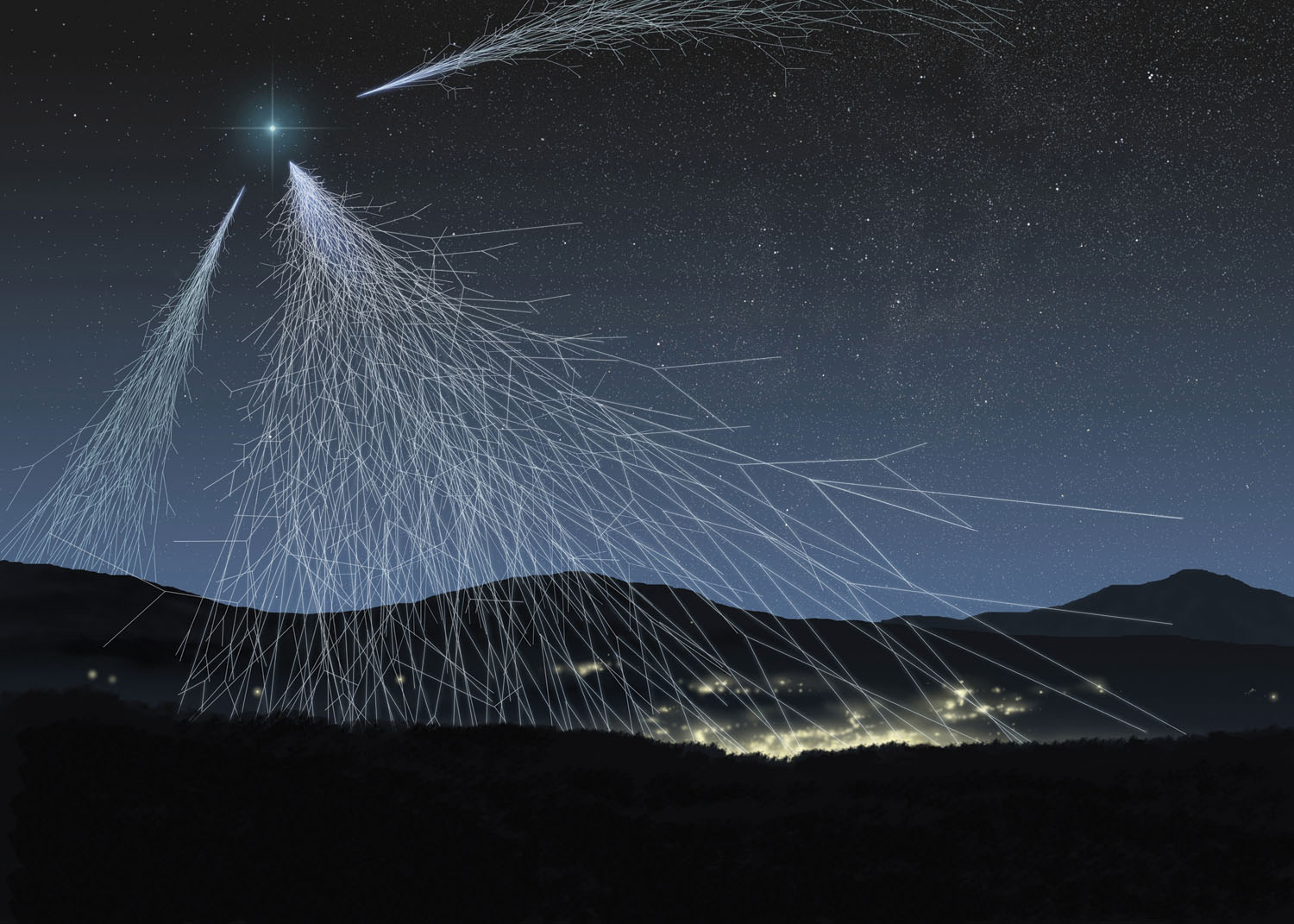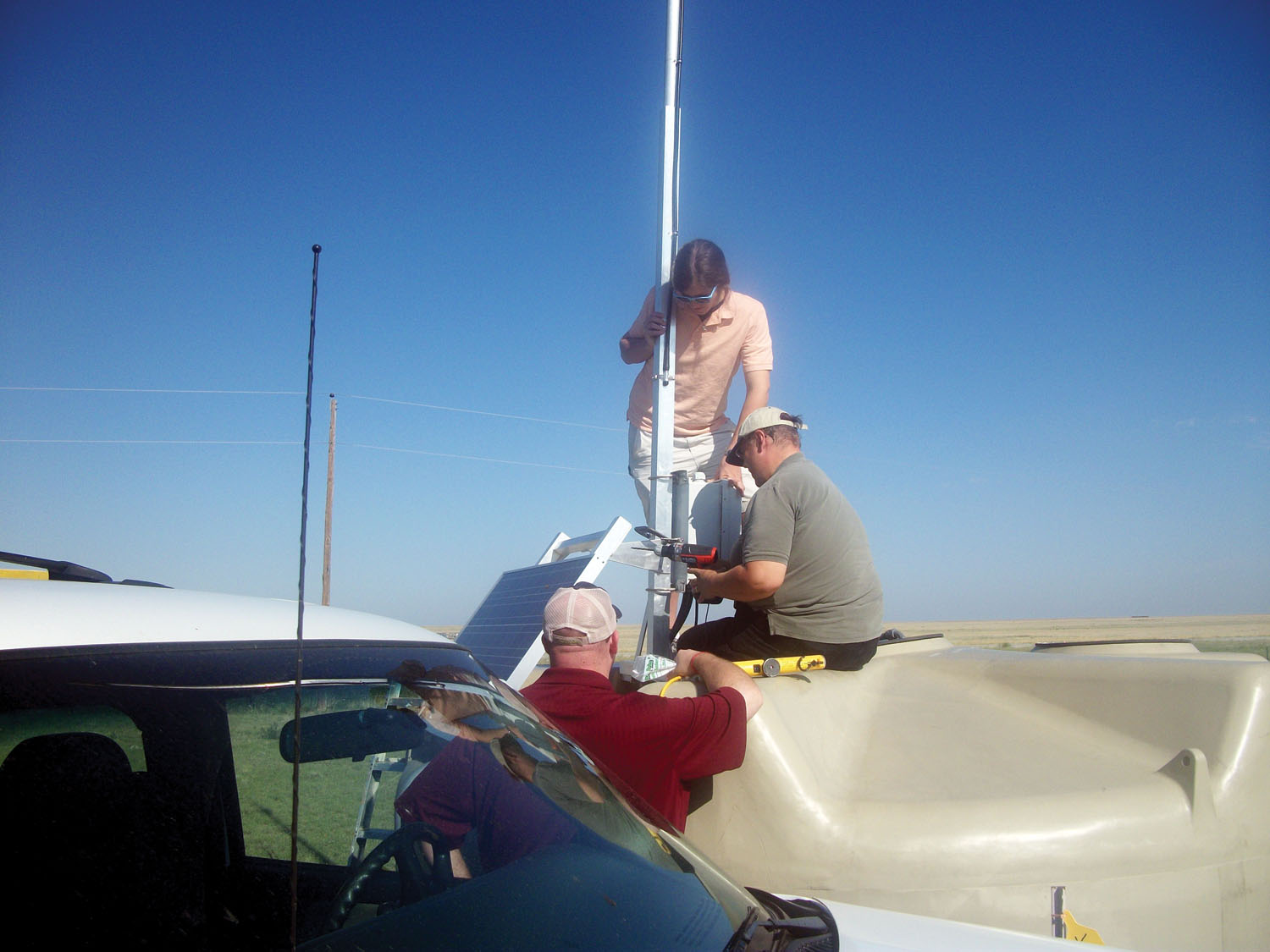
Hurtling through space, charged subatomic particles of various energies, collectively dubbed cosmic rays, hit air nuclei high in the atmosphere and shower to Earth in a cascade of secondary particles.
It is the tracks and traces of these remnants of the primary cosmic-ray particles that Wichita State professor and director of physics Nick Solomey and others working on the development of the $127 million northern test site of the Pierre Auger Cosmic Ray Observatory are plotting to detect and analyze. And it is the particles with the highest energies – the rarest of the rare – that they most hope to catch.
That’s because cosmic-ray particles with low to moderate energies are plentiful (every second, about 200 cosmic ray particles with energies of a few million electron volts hit every square meter of the earth), and they’re relatively well understood. They, for instance, have been tracked back to their starting places in supernovae. But with each passing decade, scientists have discovered higher-energy, and increasingly rare, cosmic rays. The ultra-high-energy particles, those with extreme kinetic energy far beyond what’s typical of other cosmic rays – they remain mysterious.
In fact, the very highest-energy cosmic rays ever observed defy theory. It’s as if researchers looking to catch a special species of butterfly, nabbed a fighter aircraft instead. “There are too many (cosmic rays) to all have originated in supernovae,” Solomey says, adding that scientists just don’t know that much about the most energetic cosmic-ray particles. Where do they come from? Where do they get their energy from? What are their compositions as primary particles before interacting with particles on Earth? What might their relationship with dark matter and dark energy be? What can these “messengers from the very distant past,” as Solomey describes them, tell us about the earliest times of the universe, about the Big Bang?
Answers to those questions and more are being sought by physicists worldwide. Since 2004, some 500 of them, hailing from 19 countries, have been collecting and analyzing data at the southern Pierre Auger Observatory in Argentina. Among the findings to date: the highest-energy cosmic rays that strike Earth seem to be linked with supermassive black holes.

Observatory near Lamar, Colo., are Wichita State
professor and director of physics Nick Solomey, in gray,
and students Matt Onstott, standing, and Richard Bonde.
Named after Pierre Auger (1899-1993), the French physicist who found that seemingly separate cosmic radiation events are actually associated with a single event, an air shower – the Auger project is the largest scientific enterprise ever conducted in the search for the unknown sources of ultra-high energy cosmic rays.
The southern observatory is a hybrid detector; it uses two independent methods to detect and study high-energy cosmic rays, Solomey explains.
One method detects high-energy particles through their interaction with water placed in surface detector tanks. The other technique tracks the development of air showers by observing ultraviolet light emitted high in the Earth’s atmosphere.
With its 1,500 surface detector tanks, the southern observatory covers a large area. But it needs to cover even more territory.
For one thing, cosmic rays above the energy of 10(18) eV fall to Earth at the rate of one particle each week on an area of one square kilometer, and particles above 1020 ev fall at the rate of one particle per square kilometer in a century.
So now, Solomey says, Wichita State, Fermilab in Illinois, Colorado State, Colorado School of Mines, Michigan Technical University, Case Western University and the University of Paris VII are working together to set up the southern array’s northern partner, which, when (and if) built to its full scope, will have 8,000 detector tanks arrayed across a 100-by-100-mile area near Lamar, Colo., an area that could include parts of western Kansas.
“One Kansas congressman has already called me to talk about the job possibilities,” Solomey says, but cautions that the project is only in the beginning of a one-year test period to make sure the equipment can be made operational and that the data generated will be worth the dollars spent.
“There are a number of things that are different here, when compared to the southern array in Argentina,” notes Solomey, who came to Wichita State nearly five years ago from the University of Chicago. “It’s actually higher there – 4,000 feet above sea level to 3,800 feet here. But it doesn’t freeze there, and it does here.” All kinds of details like that, he says, must be taken into consideration as the components of the northern array are set up and tested.
During the test phase, Solomey, WSU assistant professor Holger Meyer and physics students Jeanette Bergkamp, Richard Bonde and Matthew Onstott will be in charge of maintaining the control room for the northern array. Bergkamp, Bonde and Onstott are responsible for helping develop the software that observes the site in Lamar. Located in WSU’s Jabara Hall, the control room was paid for in part by a contribution from math and physics alumnus Bill Simon ’70/71.
“The Auger project is a great opportunity for us – faculty and students, both – because it’s a worldwide priority project in astro-physics that will bring great attention to our physics program,” Solomey says, adding, “I think the students will take from it the concept of how you build something big. Usually, you have a lot of people doing little things in a lab. But how do you build something like the Hubble Space Telescope? They are seeing that for the first time.”
Last September, James Cronin, a professor of physics at the University of Chicago and a lead scientist for the Pierre Auger Observatory, was on campus to talk about cosmic ray research. He called his lecture Serendipity, Colorful Scientists and the Birth of Sub-atomic Physics.
This September, things are close to operational at the northern array. “As of last weekend,” Solomey says, “we’re almost ready to go. We’re just waiting on one more component to arrive and be put into place…”
Let the particles shower down.
– Contributing, Lainie Ruscoe





